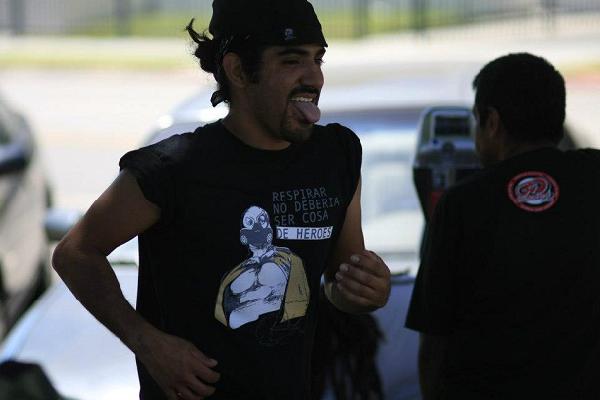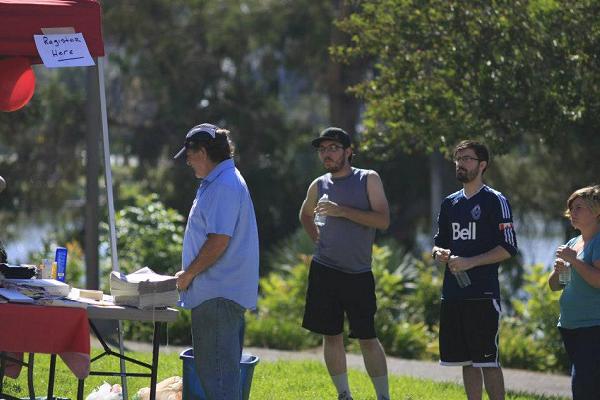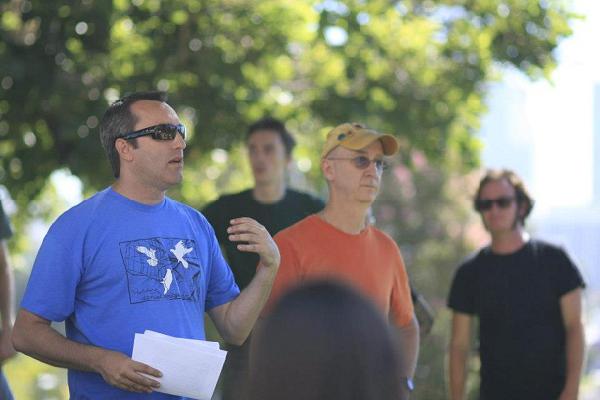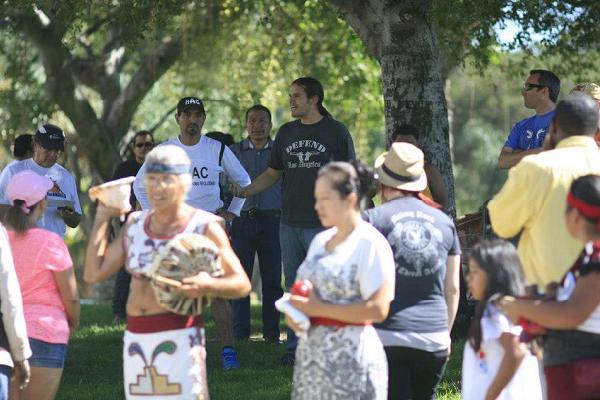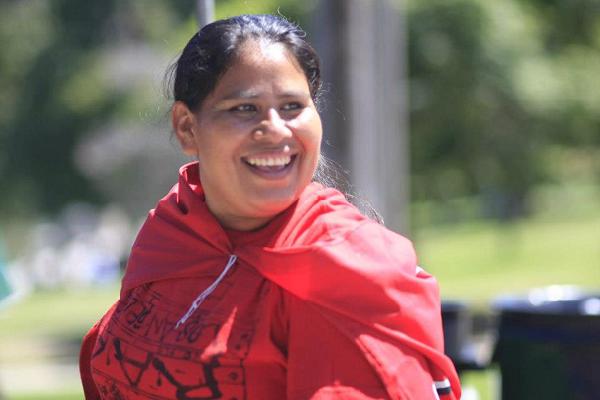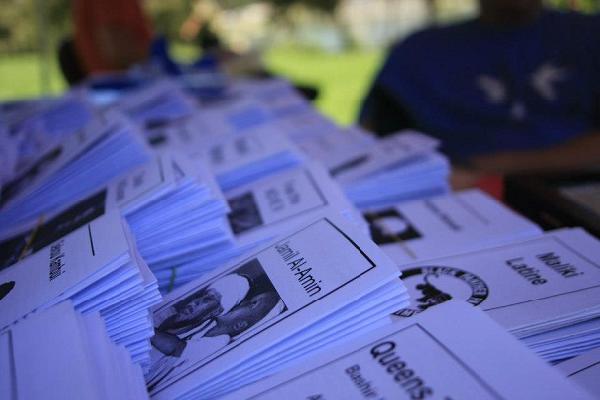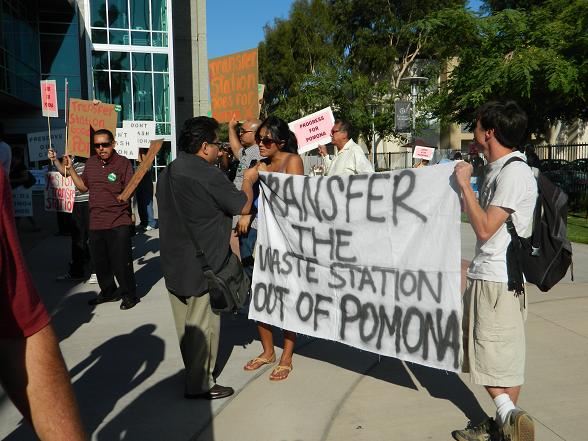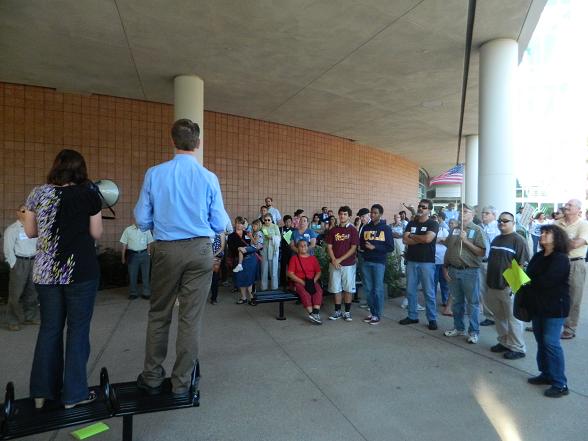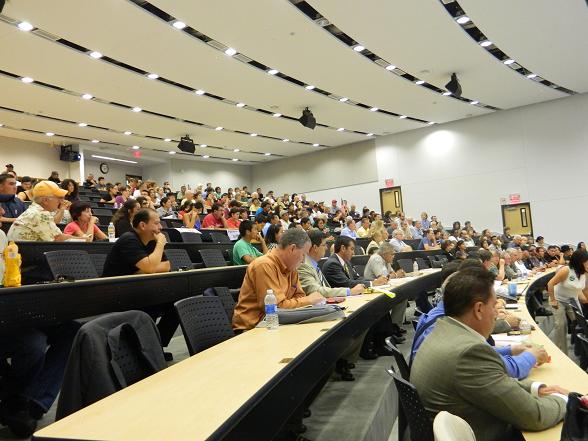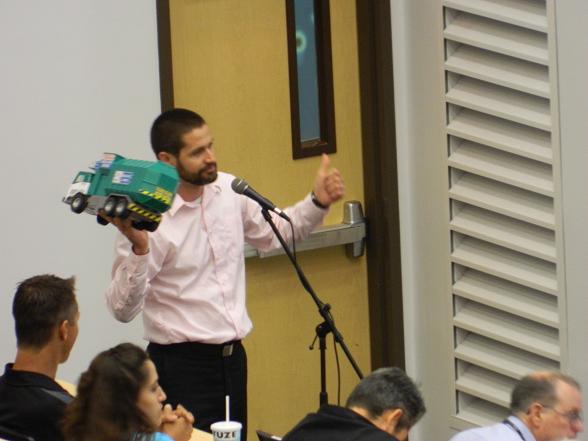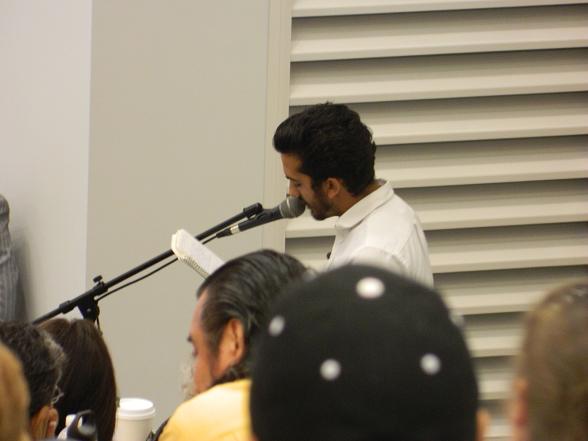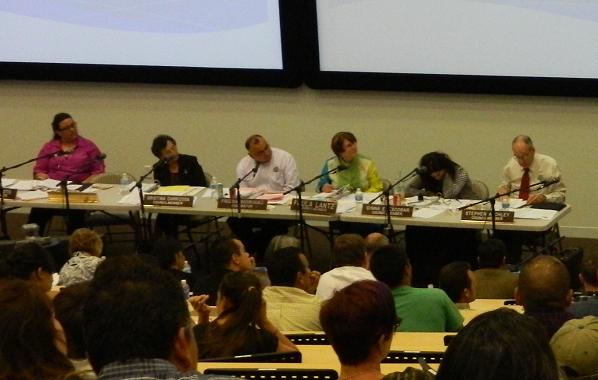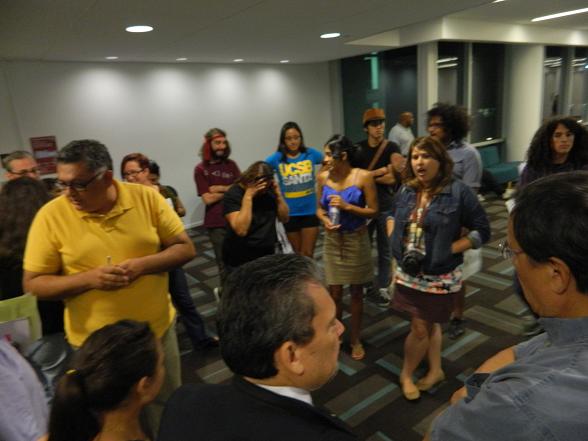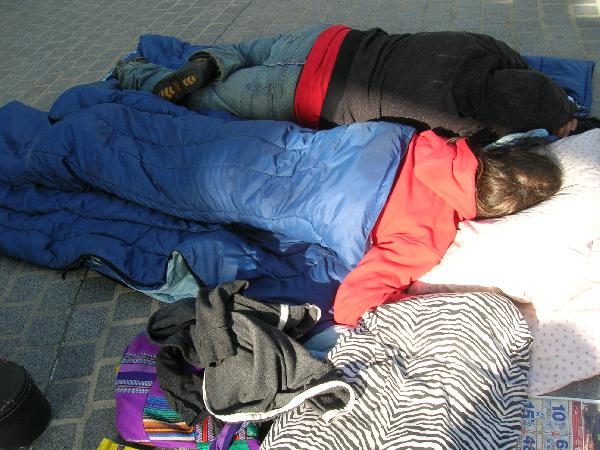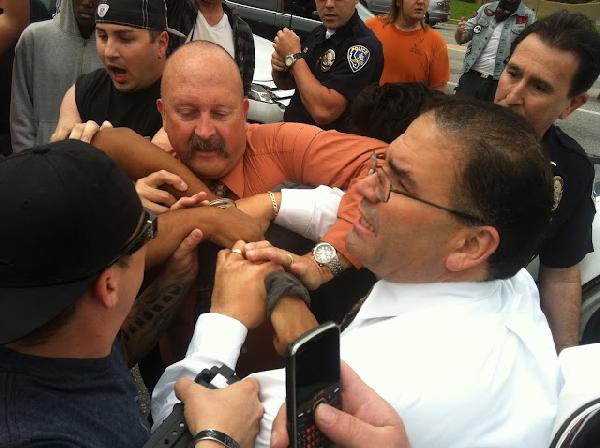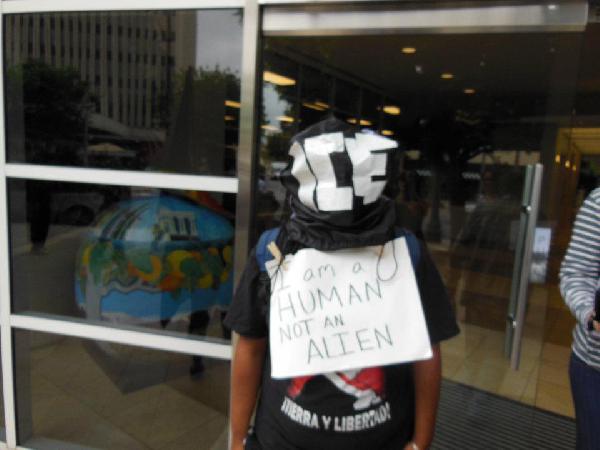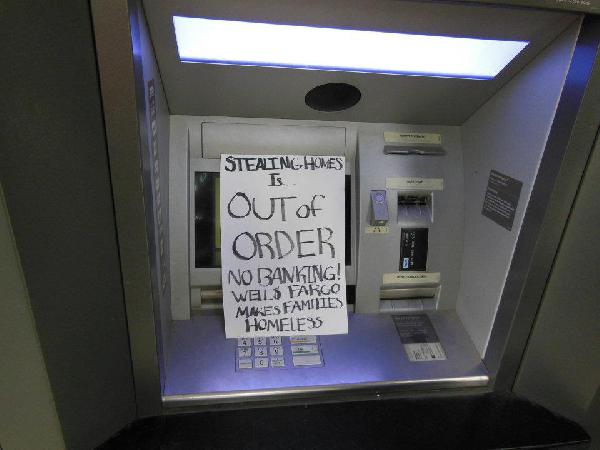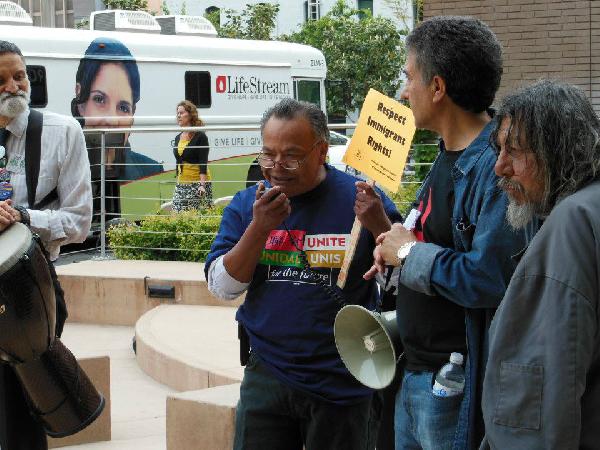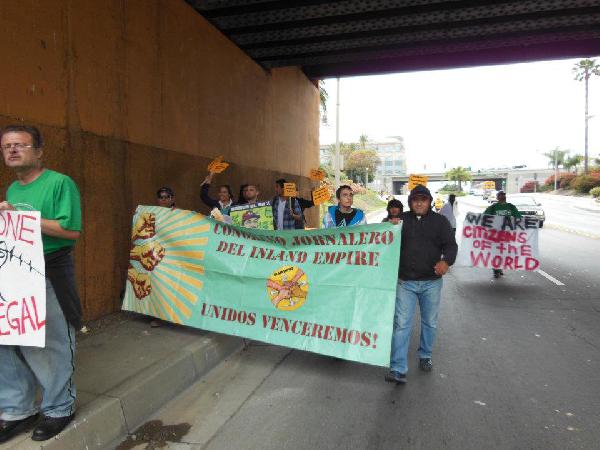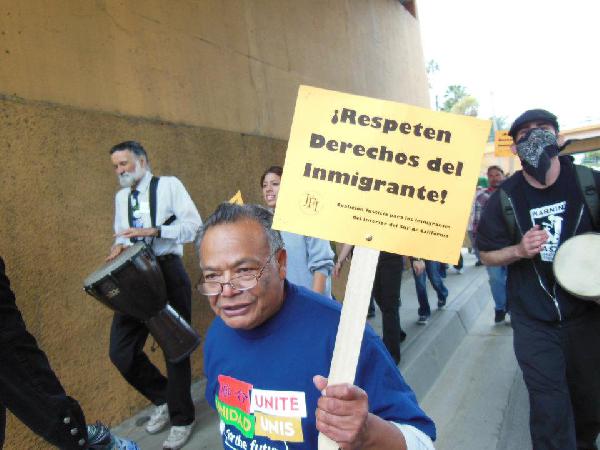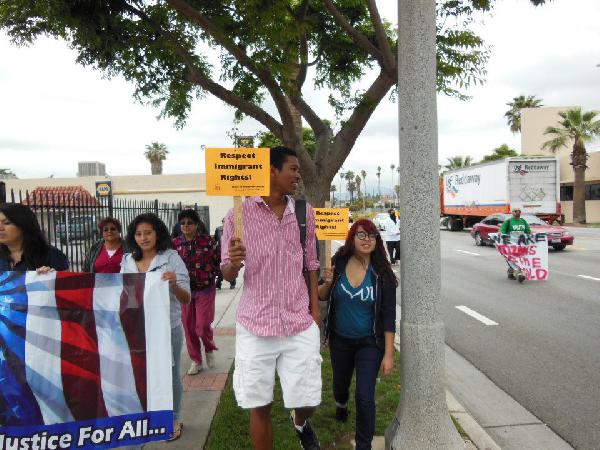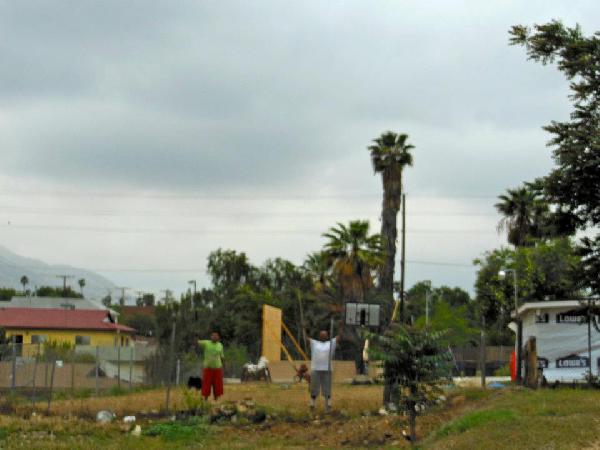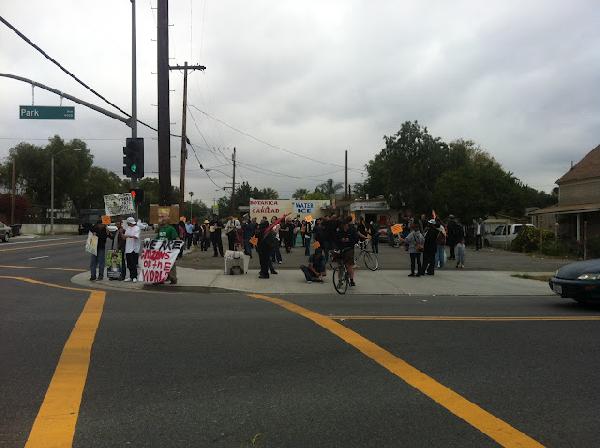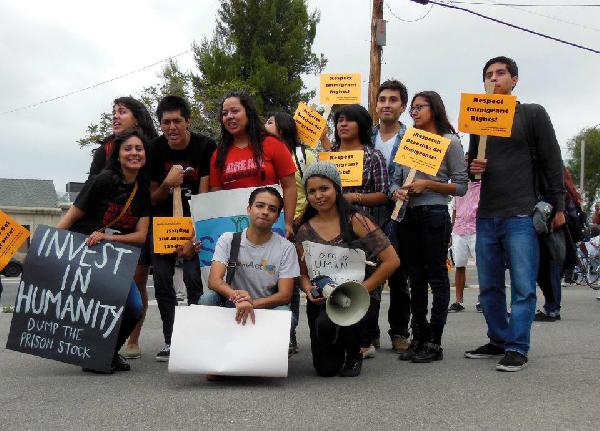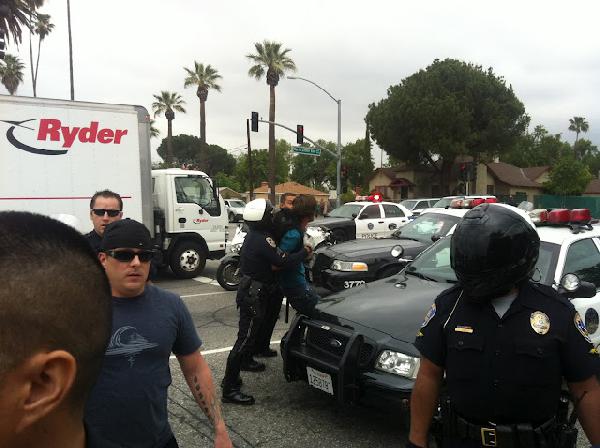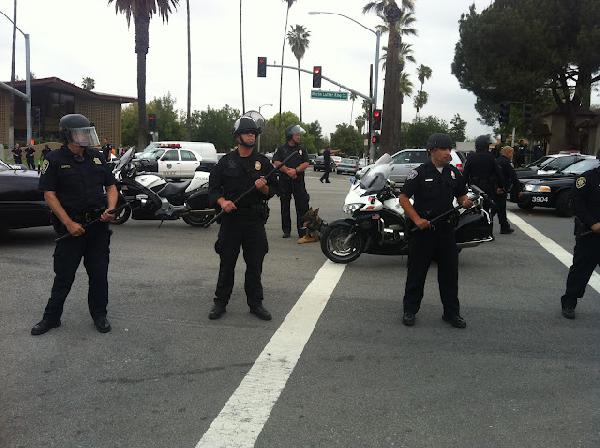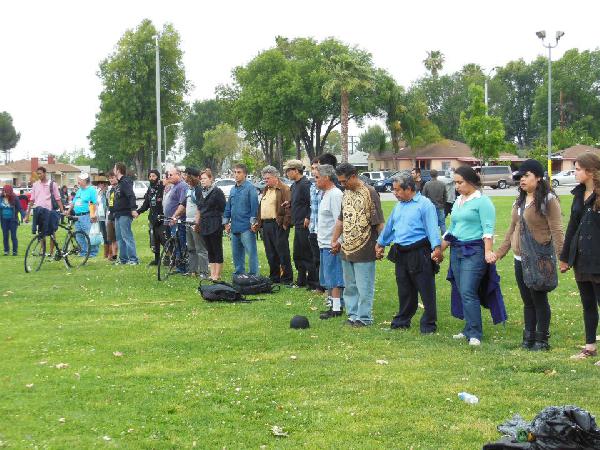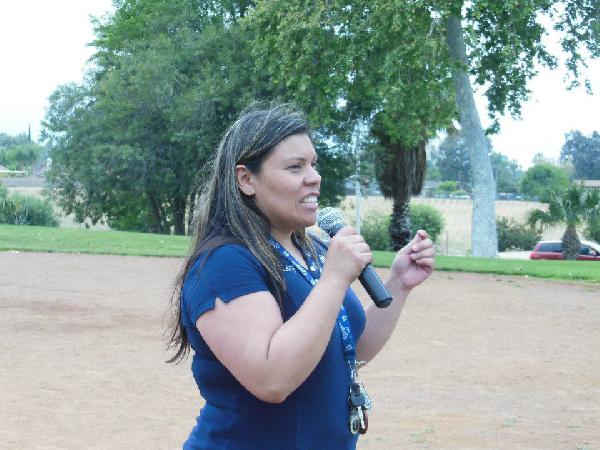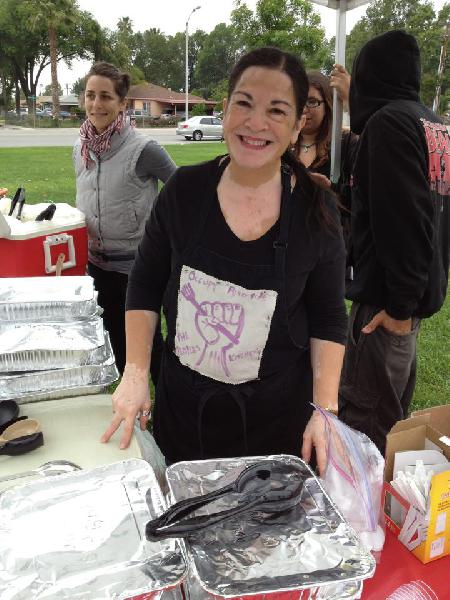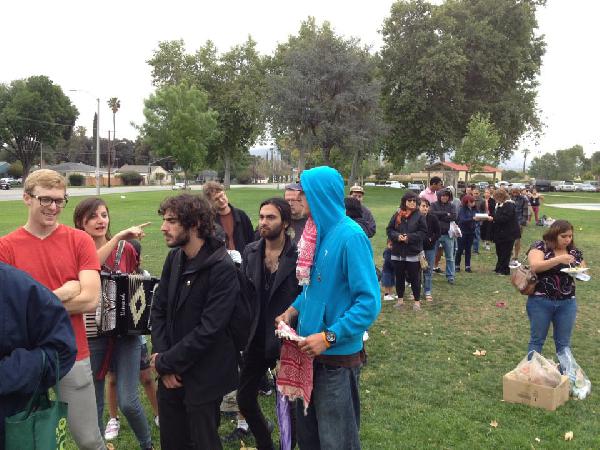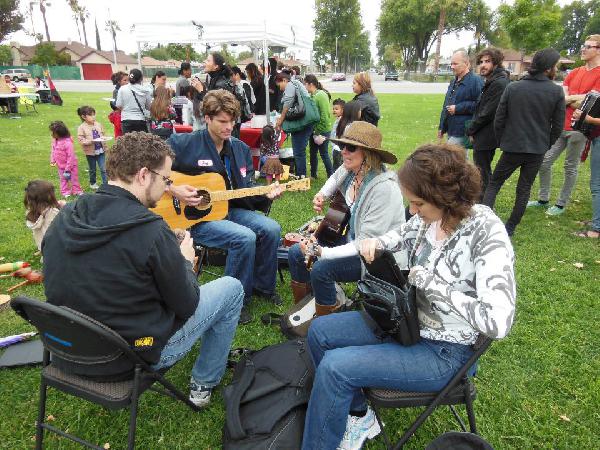http://la.indymedia.org/news/2012/09/255365.php
by Rockero, photos by Lane Farnham Monday, Sep. 03, 2012 at 5:01 PM
rockero420@yahoo.com
by Rockero, photos by Lane Farnham Monday, Sep. 03, 2012 at 5:01 PM
rockero420@yahoo.com
Throughout the US and Canada, chapters of the Anarchist Black Cross Federation held simultaneous runs to raise funds for the needs of political prisoners and prisoners of war, as well as to continue to chip away at the system that massively incarcerates impoverished people and colonized people worldwide. Runs were also held at four prisons. In Los Angeles, the event drew about thirty runners to MacArthur Park. There they joined members of Revolutionary Autonomous Communities who were present for the weekly food program, danzantes from Danza Cuauhtémoc, in attendance to bless the run, and supporters from the radical community throughout Southern California. The over $1000 raised was split between ABC to replenish the warchest and RAC to support its ongoing mutual aid and organizing efforts.
A lo largo de los Estados Unidos y Canadá, comités de la Federación Cruz Negra Anarquista (ABC, por sus siglas en inglés) realizaron carreras simultáneas para recaudar fondos para las necesidades de presxs políticxs, al igual que para seguir derrotando el sistema que encarcela a una escala masiva a gente empobrecida y gente colonizada por todo el mundo. También se efectuaron carreras en cuatro penales. En Los Ángeles, alrededor de treinta partícipes asistieron al evento en el Parque MacArthur. A sus filas se sumaron integrantes de Comunidades Autónomas Revolucionarias (RAC, por sus siglas en inglés), quienes se presentan cada domingo para su programa semanal de repartición de alimentos, danzantes de Danza Cuauhtémoc, quienes llegaron para bendecir el evento, y adherentes de comunidades radicales de todas partes del sur de California. La suma de la recaudación, que superó mil dólares, se dividirá entre ABC para suplir su tesoro y RAC para solvemtar sus esfuerzos organizativos y de asistencia mutua.
There are dozens of political prisoners and prisoners of war currently being held in US prisons.1 The majority of them were active in the liberation struggles, especially the Black liberation struggle, of the 60s and 70s, although some of them have been captured due to their involvement in more recent struggles. Other former prisoners have died in prison from assassination (such as George Jackson and Joseph Waddell), old age, and illness (such as Kuwasi Bulagoon), due in part to the inadequate medical care provided to prisoners, which is aggravated for political prisoners. Some freedom fighters, such as Safiya Bukhari and Ojore Lutalo, have served lengthy sentences and have since been released. (Bukhari has since passed away.) At least one prisoner was freed by her comrades, and now is safe in exile in Cuba (Assata Shakur). It is also important to note that some prisoners, while not originally incarcerated for political activity, become politicized and engage in struggle once on the inside, and often face repurcussions for their political activity.
The Anarchist Black Cross exists to provide support to those who are paying the consequences for revolutionary activity. One of the primary ways that support is provided is financially. Prisoners are detached from any form of self-sufficiency and are unable to meet basic needs, and the ABC helps to fill that gap. ABC also helps provide support to prisoners returning to the struggle on the outside once they have finished their sentences. Finally, ABC promotes awareness of political prisoners and prisoners of war and the need to support them as part of the larger struggle for social justice by publishing and distributing literature.
The Los Angeles chapter of ABC is one of the longest-standing chapters in the country, and in addition to the work around prisoners, has contributed the preservation of historical memory of Los Angeles radicalism through its website and its historical walking tours. (The walking tours are now being carried out under the auspices of the Black Rose Society, which will hold a tour of San Pedro on September 15 that will focus on the history of the IWW in the port and the 1923 general strike.)
Prior to the run, Cuco from the danzas led an indigenous ceremony to ask permission from the four directions, as well as from other cosmic forces, to carry out the events. The ceremony was followed by statements of solidarity received from prisoners, as well as a statement from the Mexico City chapter of ABC.
Here are the statements:
Runners then braved high temperatures to join comrades in Brooklyn, Tucson, Denver, Connecticut River (Massachussets), Berkeley, as well is in the Canadian cities of Guelph (Ontario) and Penticton (British Columbia) in running down the walls. Prisons joining in solidarity runs included USP Terre Haute, USP Tucson, FCI Terminal Island, and USP Big Sandy.
Most participants took three laps around the perimeter of MacArthur Park, which measures approximately three miles. Some cycled, while others walked. Some pushed babies in strollers. As they finished their laps, triumphant runners were cheered by a crowd of spectators. They then ate food and drank water in celebration with other members of the community.
Those interested in freeing all political prisoners were urged to join the Jericho Movement, which will be meeting at the Southern California library on September 15 at 5:PM.
_________________________________
1. The Jericho Movement lists 67 political prisoners on its website. http://www.thejerichomovement.com/prisoners.html The Anarchist Black Cross lists 48. http://www.abcf.net/abcf.asp?page=prisoners\
Actualmente decenas de presxs políticxs y prisionerxs de guerra están recluídos en prisiones estadounidenses.1 En su mayoría, fueron partícipes en las luchas sociales de los 60 y los 70, en particular la lucha por la liberación negra, aunque a algunxs se les capturó debido a su participación en luchas más recientes. Otrxs ex-presxs se han muerto encarcelado, ya sea por asesinato (como en los casos de George Jackson y Joseph Waddell), vejez, y enfermedad (como Kuwasi Bulagoon). Los casos de enfermedad se deben parcialmente a la insuficiencia de cuidado médico en el sistema carcelario, la cual que se agrava para presxs políticxs. Algunxs luchadorxs por la libertad, como Safiya Bukhari y Ojore Lutalo, han salido a la libertad después de largas sentencias. (Bukhari falleció en 2003.) Por lo menos una prisionera fue liberada por sus compañerxs, y ahora vive en la seguridad del destierro en Cuba (Assata Shakur). Cabe destacar que algunxs reos, aunque no encarceladxs por actividad en un principio, se politizan y luchan ya estando adentro, y a menudo enfrentan represalias por su actividad política.
Cruz Negra Anarquista existe para proporcionar apoyo para lxs que están pagando las consecuencias de su actividad revolucionaria. Una de las principales maneras de brindar ese apoyo es monetariamente. A lxs presxs se les despoja cualquier forma de ser autosuficiente y por consecuente, no alcanzan solventar sus necesidades apremiantes. La Cruz Negra ayuda a llenar esa carencia económica. Por último, ABC conscientiza en torno a presxs políticxs y prisionerxs de guerra y sensibiliza acerca de la necesidad de apoyarlxs como parte de la lucha más amplia por la justicia social mediante la publicación y repartición de literatura.
El comité de ABC de Los Ángeles es uno de los comité de más larga trayectoria en el país, y en adición a su trabajo carcelario, ha contribuído a la preservación de la memoria histórica del radicalismo angelino a través de su sitio web y sus caminatas históricas. (Estas caminatas son auspiciadas hoy en día por la Sociedad Rosa Negra, la cual realizará una caminata por San Pedro el 15 de septiembre que enfocará sobre la historia del IWW en el puerto y la huelga general de 1923.)
Antes de la carrera, el danzante Cuco dirigió una ceremonia indígena para pedir permiso para llevar a cabo el evento de los cuatro puntos cardinales, al igual que de las demas fuerzas cósmicas. En seguida de la ceremonia, se leyeron declaraciones de solidaridad de ciertos presos, y también un mensaje del comité defequeño de la Cruz Negra Anarquista.
Las declaraciones fueron las siguientes:
Luego lxs carreristas desafiaron las altas temperaturas para unirse con compañerxs de Brooklyn, Tucsón, Denver, Río Connecticut (Massachussets), Berkeley, al igual que en las ciudades canadienses de Penticton (Colombia Británica) y Guelph (Ontario). Reclusorios que participaron en carreras solidarias incluyeron USP Terre Haute, USP Tucsón, FCI Terminal Island, y USO Big Sandy.
La mayoría de lxs participantes dieron tres vueltas al perímetro del parque, lo cual que mide aproximadamente tres millas. Algunxs anduvieron en bicicleta, mientras que otrxs caminaron. Algunxs empujaron carriolas con niñxs. En lo que terminaban sus vueltas, una multitud de espectadores echaron porras a lxs carreristas triunfantes. Luego comieron y bebieron agua con otrxs miembros de la comunidad.
A la gente a la que se le interese liberar a todxs lxs presxs políticxs, se les instó a unirse al Movimiento Jericó, que tendrá reunión el 15 de septiembre a las cinco PM en la Biblioteca del Sur de California.
__________________________
1. El Movimiento Jericó nombra a 67 presxs políticxs en su sitio de internet. http://www.thejerichomovement.com/prisoners.html La Cruz Negra Anarquista maneja una lista de 48. http://www.abcf.net/abcf.asp?page=prisoners
The Anarchist Black Cross exists to provide support to those who are paying the consequences for revolutionary activity. One of the primary ways that support is provided is financially. Prisoners are detached from any form of self-sufficiency and are unable to meet basic needs, and the ABC helps to fill that gap. ABC also helps provide support to prisoners returning to the struggle on the outside once they have finished their sentences. Finally, ABC promotes awareness of political prisoners and prisoners of war and the need to support them as part of the larger struggle for social justice by publishing and distributing literature.
The Los Angeles chapter of ABC is one of the longest-standing chapters in the country, and in addition to the work around prisoners, has contributed the preservation of historical memory of Los Angeles radicalism through its website and its historical walking tours. (The walking tours are now being carried out under the auspices of the Black Rose Society, which will hold a tour of San Pedro on September 15 that will focus on the history of the IWW in the port and the 1923 general strike.)
Prior to the run, Cuco from the danzas led an indigenous ceremony to ask permission from the four directions, as well as from other cosmic forces, to carry out the events. The ceremony was followed by statements of solidarity received from prisoners, as well as a statement from the Mexico City chapter of ABC.
Here are the statements:
The ABCF Warchest Program helps us. Thank you for attending to our basic financial needs. You don’t talk about it, you be about it. Thus I take great pride in and am comforted by your steadfast support of our political prisoners and POWs.
Your consistency in this regard and your social practice in general – “telling no lies and claiming no easy victories, “ is commendable. You teach by example.
Therefore, I strongly support you and the solidarity run. The race goes not to the swiftest but to those who endure.
Your Brother,
Herman Bell
Solidarity isn’t an abstract idea haphazardly thrown around like craps. Solidarity is a way of consciously living that is explicitly interwoven into an anarchists existence. Such a way of being transcends nation-state borders, prison walls, electric fences, and fascist barricades. Direct action infused in solidarity with us on the inside and you on the outside not only challenges systematic mass incarceration, but it shatters the social relations perpetuated by the prison industrial complex. Although I am behind prison walls in a scorching California desert, I am under the same sky, under the same sun, and am running down the same walls with you in solidarity towards freedom.
Phillip "Nomas" Ruiz
Blythe, California
To All Runners of Los Angeles,
My name is Oso Blanco. I am a powerful warrior; good things are going to come to me- big positive things- so I may be set free from fed prison and return to helping others. Before the universe I say, “Let is be so!” I say to the universe and all of you for RDTW – For we are all related and part of the universe, “Rise Up! Make it happen!” The government holds me hostage because of my inner power and I say reverse this with me. Set us all free.
Love Oso Blanco, EZLN supply line warrior.
My thanks to you all for choosing to participate in an active remembrance of those hidden by the state. in our simplest and smallest acts we can nourish healthy communities and by coming together through intention our reach expands to embrace even those in the belly of the beast who may feel as though they cannot contribute. here's to the removal of the walls which separate us, and those systems which slow their natural pattern in life = to crumble.
Eric McDavid, ELF PP
To ABCLA
To the runners
A short message just to send a greeting from Mexican land. We want this event to be a success and that soon we see all the walls fall down, not just those who are holding many of our comrades in prison, but also those that divide us by borders.
Here in Mexico we have two imprisoned anarchist comrades, but there are thousands of people in prison just because they are poor or indigenous. As ABC we are working for the destruction of these killing centers that prisons are and we are very happy to continue this fight with you.
Falling all the walls!
Solidarity forever!
ABC Cruz Negra Anarquista México
Dear Friends in the LA ABCF
Thanks so much for you letter regarding the planned Running Down the Walls. I got it on July 19th. I was afraid, frankly to say, your notice also evaporated as some of my letters do, incoming as well as outgoing. Therefore, I felt happy to know.
Anyhow, we, in FCI Terre Haute population, have organized a solidarity run with Running Down the Walls on the same day, but time is of choosing, forgive us.
The summer is extremely hot in this area, as you might know. I myself am in good condition since I run a little over 5k daily. Thus, I’m ready for the planned run. I hope your planned run is successful.
In Solidarity,
T. Shirosaki July 22, 2012.
Runners then braved high temperatures to join comrades in Brooklyn, Tucson, Denver, Connecticut River (Massachussets), Berkeley, as well is in the Canadian cities of Guelph (Ontario) and Penticton (British Columbia) in running down the walls. Prisons joining in solidarity runs included USP Terre Haute, USP Tucson, FCI Terminal Island, and USP Big Sandy.
Most participants took three laps around the perimeter of MacArthur Park, which measures approximately three miles. Some cycled, while others walked. Some pushed babies in strollers. As they finished their laps, triumphant runners were cheered by a crowd of spectators. They then ate food and drank water in celebration with other members of the community.
Those interested in freeing all political prisoners were urged to join the Jericho Movement, which will be meeting at the Southern California library on September 15 at 5:PM.
_________________________________
1. The Jericho Movement lists 67 political prisoners on its website. http://www.thejerichomovement.com/prisoners.html The Anarchist Black Cross lists 48. http://www.abcf.net/abcf.asp?page=prisoners\
Actualmente decenas de presxs políticxs y prisionerxs de guerra están recluídos en prisiones estadounidenses.1 En su mayoría, fueron partícipes en las luchas sociales de los 60 y los 70, en particular la lucha por la liberación negra, aunque a algunxs se les capturó debido a su participación en luchas más recientes. Otrxs ex-presxs se han muerto encarcelado, ya sea por asesinato (como en los casos de George Jackson y Joseph Waddell), vejez, y enfermedad (como Kuwasi Bulagoon). Los casos de enfermedad se deben parcialmente a la insuficiencia de cuidado médico en el sistema carcelario, la cual que se agrava para presxs políticxs. Algunxs luchadorxs por la libertad, como Safiya Bukhari y Ojore Lutalo, han salido a la libertad después de largas sentencias. (Bukhari falleció en 2003.) Por lo menos una prisionera fue liberada por sus compañerxs, y ahora vive en la seguridad del destierro en Cuba (Assata Shakur). Cabe destacar que algunxs reos, aunque no encarceladxs por actividad en un principio, se politizan y luchan ya estando adentro, y a menudo enfrentan represalias por su actividad política.
Cruz Negra Anarquista existe para proporcionar apoyo para lxs que están pagando las consecuencias de su actividad revolucionaria. Una de las principales maneras de brindar ese apoyo es monetariamente. A lxs presxs se les despoja cualquier forma de ser autosuficiente y por consecuente, no alcanzan solventar sus necesidades apremiantes. La Cruz Negra ayuda a llenar esa carencia económica. Por último, ABC conscientiza en torno a presxs políticxs y prisionerxs de guerra y sensibiliza acerca de la necesidad de apoyarlxs como parte de la lucha más amplia por la justicia social mediante la publicación y repartición de literatura.
El comité de ABC de Los Ángeles es uno de los comité de más larga trayectoria en el país, y en adición a su trabajo carcelario, ha contribuído a la preservación de la memoria histórica del radicalismo angelino a través de su sitio web y sus caminatas históricas. (Estas caminatas son auspiciadas hoy en día por la Sociedad Rosa Negra, la cual realizará una caminata por San Pedro el 15 de septiembre que enfocará sobre la historia del IWW en el puerto y la huelga general de 1923.)
Antes de la carrera, el danzante Cuco dirigió una ceremonia indígena para pedir permiso para llevar a cabo el evento de los cuatro puntos cardinales, al igual que de las demas fuerzas cósmicas. En seguida de la ceremonia, se leyeron declaraciones de solidaridad de ciertos presos, y también un mensaje del comité defequeño de la Cruz Negra Anarquista.
Las declaraciones fueron las siguientes:
El programa del Tesoro de ABCF nos ayuda. Gracias por atender a nuestras necesidades financieras básicas. Ustedes no hablan de ser solidarios y solidarias, ustedes en verdad lo son. Por ende, me da mucho orgullo y socorro su apoyo consistente de nuestrxs presxs políticxs y prisionerxs de guerra.
Su constancia en este respecto y su práctica de justicia social en general de "no echar mentiras ni tomar el mérito para ninguan victoria fácil" es loable. Enseñan por ejemplo.
Por consecuente, lxs apoyo fuertemente y apoyo su carrera de solidaridad. La persona que perdura, no la que termina primero, es la que gana.
Su hermano,
Herman Bell.
La solidaridad no es una idea abstacta que se avienta al azar como un par de dados, sino una manera de vivir conscientemente que se teje explícitamente con la existencia del o de la anarquista. Tal es una manera de ser que transciende las fronteras del estado-nación, los muros de los penales, las bardas eléctricas, y las barricadas fascistas. La acción directa infundida con solidaridad con nosotrxs que estamos adentro, y ustedes por fuera, no sólamente le pone reto al encarcelamiento masivo, sino que despedaza las relaciones sociales perpetuadas por el complejo industrial penal. Aunque me encuentre detrás de la rejas en un desierto chamuscante de California, estoy bajo el mismo cielo, bajo el mismo sol, y estoy corriendo para aniquilar los mismos muros con ustedes en solidaridad hacia la libertad.
Phillip "Nomas" Ruiz
Blythe, California
A todxs lxs carreristas de Los Ángeles
Mi nombre es Oso Blanco. Soy guerrero poderoso; cosas buenas me queda por delante, cosas grandes y positivas, para que me liberen de la prisión federal y regrese a ayudar al prójimo.
Ante el universo, declaro "¡Que así sea!" Se lo digo al universo y a todxs ustedes para RDTW - porque todxs somos parientes y formamos parte del universo, "¡Levántense! ¡Háganlo realidad!" El gobierno me tiene de rehén por mi poder interior, y yo digo, deshagan esto conmigo. Libertad para todxs.
Amor de Oso Blanco
Guerrero de línea de apoyo material al EZLN.
Mis agradecimientos a todxs ustedes por elegir participar en una membranza activa de lxs que esconde el estado. en nuestros hechos más pequeños y simples podemos nutrir comunidades sanas, y al unirse a través de nuestra intención, se expande nuestro alcance para abrazar incluso a lxs que están en el vientre de la bestia que puedan sentir que no tiene cómo contribuir. un brindis a la quitada de los muros que nos separan, y aquellos sistemas que atrasan su secuencia natural de vida = que se desmoronen.
Eric McDavid, PP del ELF
Para ABCLA
A lxs carreristas
Un mensaje breve nada más para mandar un saluido de tierras mexicanas. Queremos que este evenot sea un éxito y que pronot veamos caer todos los muros, no sólo los que encierran a muchxs de muestrxs compañerxs en la prisión, sino también los que nos dividen por fronteras.
Aquí en México hemos dos camaradas anarquistas presos, pero son miles de gente encarcelada sólo porque son pobres o indígenas. Como ABC estamos trabajando para la destrucción de estos centros de matanza que son las prisiones y estamos contentxs de continuar esta lucha con ustedes.
¡Que se caigan todos los muros!
¡Solidaridad siempre!
ABC Cruz Negra Anarquista México
Queridxs amigxs en la ABCF de LA Tantas gracias por su carta concerniente la planeada Carrera para Bajar los Muros. Me llegó el 19 de julio. Tenía miedo, para decirles francamente, la noticia también evaporó así como algunas de mis cartas, tantas las entrantes como las salientes. Por lo tanto, me sentí contenco de saber.
Bueno, nosotros de la población de FCI Terre Haute, hemos organizado una carrera de solidaridad para el mismo día, pero el tiempo es de [nuestra] elección, perdónennos.
En verano hace un calor estremo en esta área, así como tal vez lo sepan. Por mi cuenta estoy en buenas condiciones ya que corro un poco más de 5k diario. Por eso, estoy listo para la carrera planeada. Espero que su carrera programasa sea exitosa.
En solidaridad,
T. Shirosaki
Julio 22, 2012
Luego lxs carreristas desafiaron las altas temperaturas para unirse con compañerxs de Brooklyn, Tucsón, Denver, Río Connecticut (Massachussets), Berkeley, al igual que en las ciudades canadienses de Penticton (Colombia Británica) y Guelph (Ontario). Reclusorios que participaron en carreras solidarias incluyeron USP Terre Haute, USP Tucsón, FCI Terminal Island, y USO Big Sandy.
La mayoría de lxs participantes dieron tres vueltas al perímetro del parque, lo cual que mide aproximadamente tres millas. Algunxs anduvieron en bicicleta, mientras que otrxs caminaron. Algunxs empujaron carriolas con niñxs. En lo que terminaban sus vueltas, una multitud de espectadores echaron porras a lxs carreristas triunfantes. Luego comieron y bebieron agua con otrxs miembros de la comunidad.
A la gente a la que se le interese liberar a todxs lxs presxs políticxs, se les instó a unirse al Movimiento Jericó, que tendrá reunión el 15 de septiembre a las cinco PM en la Biblioteca del Sur de California.
__________________________
1. El Movimiento Jericó nombra a 67 presxs políticxs en su sitio de internet. http://www.thejerichomovement.com/prisoners.html La Cruz Negra Anarquista maneja una lista de 48. http://www.abcf.net/abcf.asp?page=prisoners
002
Runners lining up to register
003
Ceremonia
004
Ceremonia
005
Reading statements
006
Reading and interpreting statements
007
Supporter from RAC
008
Literature from ABC table
009
Food from RAC mutual aid program
010
Supporter from RAC
